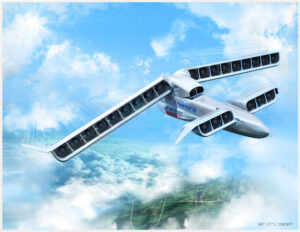Army Mulls Hybrid Electric For Next Gen Drones
Posted on

DARPA VTOL X-Plane LightningStrike (artist’s conception)
WEST PALM BEACH, Fla.: Army experts are “extremely excited” by the idea of hybrid electric aircraft, one of the service’s top Unmanned Aerial Systems (UAS) experts revealed Tuesday.
“My team has believed that was the case for some time,” Lars Ericsson, chief of the technical management division in the Army UAS office, said on a panel at the American Helicopter Society International’s annual conference here. “What we’re extremely excited to watch are the number of S&T (science and technology) programs advancing the technology.”
Ericsson cited three experimental hybrid electric aircraft programs now underway:
- DARPA’s Vertical Takeoff and Landing Experimental Aircraft program, known as VTOL X-Plane, in which Aurora Flight Sciences of Manassas, Va., is building an unmanned hybrid technology demonstrator called LightningStrike. The odd-looking plane will use a conventional turbine engine to power three 1 megawatt electric generators powering 24 electric motor-driven ducted fans in a tilting wing and a tilting canard.
- The Great Horned Owl Program (GHO), an Intelligence Advanced Research Projects Activity (IARPA) effort to develop, as the IARPA web site describes it, “technologies that significantly extend the operational endurance and payload capabilities of ISR UAVs (intelligence surveillance and reconnaissance unmanned aerial vehicles).” The first phase of the GHO program is developing “a propulsion system that will quietly generate electrical power from liquid hydrocarbon fuel,” the web site explains.
- NASA’s GL-10 Greased Lightning, a technology demonstrator aircraft that uses ten electric propellers on a 10-foot tilting wing to take off and land vertically and fly like an airplane.
A number of other U.S. and foreign companies are working on such “distributed electric propulsion” and “hybrid electric” aircraft, which are designed to escape the severe limitations of batteries that make pure electric aircraft of any size impractical by using conventional power plants to generate their electricity.
The 2020s drone being discussed wouldn’t replace the Army’s most capable unmanned aircraft, the MQ-1C Gray Eagle, which can carry four AGM-114 Hellfire missiles and fly for 24 hours at altitudes up to 25,000 feet. But Ericsson said the Army wants to get as much capability out of its future drones as it has now in its fixed-wing drones, which include the RQ-7B Shadow. The newest version of the Shadow can fly nine hours at up to 18,000 feet. The Army also wants its future drones to be able to take off and land vertically.
“Efforts like VTOL X-Plane, like Great Horned Owl, like Greased Lightning” are “extraordinarily exciting to us,” Ericsson said, “because if you look at what we are going to ask for in the ‘20s, we want to retain as much of that payload/endurance combination that we have now out of our great fixed wings…but we want to operate out of those austere areas. Runway independence is the most frequent term you hear.”
The Army also wants it 2020s drones to be able to go into more heavily defended areas than today’s UAS can, he said.
Potential adversaries know how valuable drones have become to U.S. forces and “have moved out to deny us that capability or degrade that capability,” Ericsson said. “I sometimes joke that counter UAS is a growth industry.” Beyond that, he said, “The platform we procure in the ’20s has to serve in the ’40s and ’50s. Think of what the world will look like.”
Perhaps electric?
(The American Helicopter Society International kindly provided Breaking Defense lodging during Forum 72.)
Subscribe to our newsletter
Promotions, new products and sales. Directly to your inbox.
